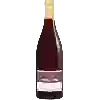
Winery La ChablisienneCuvée L. C. Chablis
In the mouth this white wine is a powerful with a nice freshness.
This wine generally goes well with pork, rich fish (salmon, tuna etc) or shellfish.
Taste structure of the Cuvée L. C. Chablis from the Winery La Chablisienne
Light | Bold | |
Dry | Sweet | |
Soft | Acidic |
In the mouth the Cuvée L. C. Chablis of Winery La Chablisienne in the region of Burgundy is a powerful with a nice freshness.
Wine flavors and olphactive analysis
On the nose the Cuvée L. C. Chablis of Winery La Chablisienne in the region of Burgundy often reveals types of flavors of apples, minerality or earth and sometimes also flavors of tree fruit, citrus fruit.
Food and wine pairings with Cuvée L. C. Chablis
Pairings that work perfectly with Cuvée L. C. Chablis
Original food and wine pairings with Cuvée L. C. Chablis
The Cuvée L. C. Chablis of Winery La Chablisienne matches generally quite well with dishes of pork, rich fish (salmon, tuna etc) or shellfish such as recipes of brussels sprouts with bacon in a casserole, smoked salmon burger - chive cream or quick crayfish chicken.
Details and technical informations about Winery La Chablisienne's Cuvée L. C. Chablis.
Discover the grape variety: Chardonnay
The white Chardonnay is a grape variety that originated in France (Burgundy). It produces a variety of grape specially used for wine making. It is rare to find this grape to eat on our tables. This variety of grape is characterized by small bunches, and small grapes. White Chardonnay can be found in many vineyards: South West, Burgundy, Jura, Languedoc & Roussillon, Cognac, Bordeaux, Beaujolais, Savoie & Bugey, Loire Valley, Champagne, Rhone Valley, Armagnac, Lorraine, Alsace, Provence & Corsica.
Last vintages of this wine
The best vintages of Cuvée L. C. Chablis from Winery La Chablisienne are 2010, 2015, 2013, 2012 and 2011.
Informations about the Winery La Chablisienne
The Winery La Chablisienne is one of of the world's great estates. It offers 63 wines for sale in the of Chablis to come and discover on site or to buy online.
The wine region of Chablis
Chablis is a historic town and wine region in NorthCentralFrance. It produces light, Dry white wines, renowned for their minerality and lively Acidity. AOC Chablis wines are produced exclusively from the Chardonnay grape. The wines of Chablis are made in a rather different style from those produced elsewhere in Burgundy.
The wine region of Burgundy
Bourgogne is the catch-all regional appellation title of the Burgundy wine region in eastern France ("Bourgogne" is the French name for Burgundy). Burgundy has a Complex and comprehensive appellation system; counting Premier Cru and Grand Cru titles, the region has over 700 appellation titles for its wines. Thus, Burgundy wines often come from one Vineyard (or several separate vineyards) without an appellation title specific to the region, Village or even vineyard. A standard Burgundy wine may be made from grapes grown in one or more of Burgundy's 300 communes.
The word of the wine: Rehoboam
Bottle with a capacity of 4.5 l.













